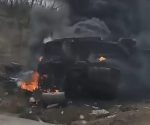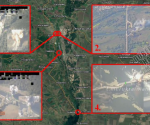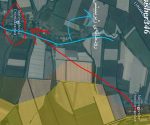The Russian winter campaign has evidently already started (?)
As the title says, evidently the Russian winter campaign (in territory formerly part of Ukraine) has already started – or, in actual fact, the fighting that was already happening continues, but according to and taking advantage of new seasonal conditions. All will be explained – including the use of the question mark.
It was written in a previous article hereabouts that “phase three begins with the noise of a dropping pin” – which was talking about how the initiative and the offensive intent of the withdrawal from Kherson had been missed in “pro-Russian” alternative media, even when it wasn’t bitching and whining about “something else going wrong”. A regular at that sort of thing – an operation that has been cause for complaint more than once before at this site – tweeted today to tell its 211,200 followers “Frontlines very static right now, except for small Russian advances in Donbass”. In fact, the exception disproves the rule, does it not? The important thing is that nearly a quarter of a million subscribers came away with a completely wrong idea, and this is how controlled opposition works to deceive. At least when liveuamap.com creates the impression of Russian listlessness by refusing to update its charts it’s not pretending to be pro-Russian.
Here’s the thing: it appears that alternative media is universally telling its audience that whatever Russia does next will come like judgment from heaven, and the earth shall tremble, and Zelensky (and his Mi6 minders) will elude capture by flying from the roof of Cossack House in Kiev with their gold, frankincense and myrrh on those three junk Sea King helicopters that have been gifted to show how UK Government’s “support for Ukraine is unwavering”.
The author thinks that things are not going to be like that – although, of course, second guessing the Russian planners is not wise, hence the necessary qualification with the use of a question mark. There’s two reasons for it. Firstly, the Russians have performed two heavy bombing raids since the Kherson withdrawal that are not purely symbolic, retributive, or meant for obtaining leverage in an agreement (something the reader may have seen touted in bait-and-switching alternative media). Secondly, its nigh on impossible to understand why the Russians would proceed any differently than they have been, given that theirs is a slow grind artillery warfare doctrine upon which a standard expectation should be formed. And in that case, small Russian advances in the Donbas are big events.
This site has already brought such things in southern Donetsk to its readership’s attention, so now look at what happens in the north.
In the graphic below, the same qualification must be given as has been before (chiefly in the article, Watch Southern Donetsk). Translating the orange line from Russian Ministry of Defence maps – which in any case are for causing an impression, but are nevertheless not fiction – is a tricky operation. The most slender of apparent advances (shown in the additional orange shading against the orange line) could be due to a tiny variation offered on a particular day in the original material, or it could come about in the translation. However, anything that is substantial will be a genuine advance in the line, and quite clearly discernible when looking at the original source and checking against previous publications of the same. The author is confident that the Russians are indicating that they have, in recent days, pushed the Ukrainians out of Lugansk but for a square mile or two here and there, have developed the area of their control north of Soledar, and taken control of the settlement shown on this Ukrainian convention base map (from liveuamap) as Kurdiumivka.
For the reader’s information, there is rarely a mention of Russian attacking operations in the Ministry of Defence’s daily briefings, and in fact there never really has been in respect of the slow grind in the Donetsk since the author has been following it (from July). One should not be surprised about the silence when one has for months observed the Russians actively misdirect regarding the advanced state of their progress (chiefly by failing to claim territory in their maps). In any case, on the 22nd November there was an announcement which was par for the course: “In Donetsk direction, units of Russian forces continued their offensive, while repelling enemy counterattacks.” Indeed, if it weren’t for the Ukrainian reaction to the Russian situation (which the Russians do allow themselves to disclose) there might not be any indicator given in briefings at all regarding Russian progress.
[Continues below the graphics]

Orange shading against the line is change in Russia’s area of control since 13th November – according to the map below and comparisons made with the situation (again, according to the Russians) as it was previously noted.

This Russian MoD map from 25th November allows a clearer view of what goes on around Bakhmut/Artyomovsk.
Aside from the movement on the ground, quite a big tell that the Russian winter operation has already begun (or rather, a program that was always underway continues under a new seasonal dynamic) are the recent heavy bombing campaigns in November that principally hollowed out Ukraine’s energy infrastructure. The usual suspects – those influencers who complain about Russia’s special military operation to create demoralisation – asked why this wasn’t done before.

There is a concern that this image, which has been doing the rounds on the internet, has been doctored. However, the thing to note is the contrast between west and central-east Ukraine where the fighting is (will be?).
The answer is simple if the destruction is understood as a precursor to an escalation in offensive activity. Why would the Russians dismantle the energy grid of Ukraine in warmer seasons of longer days when being without heat and light would not be so shocking? The Russians want to damage morale now. Moreover, the Russians want to exploit their evisceration of Ukrainian military power now, and turning eastern Ukraine especially (see the image on the right) into an infrastructural wasteland would be a tactic for the purpose. Why do it at a time when it wasn’t needed, allowing time thereafter for repairs and psychological adjustments to be made?
Look at these compiled extracts from the separate pertinent Russian Ministry of Defence briefings (emphasis added):
On 15 November, Russian Armed Forces launched a massive attack using high-precision long-range air- and sea-based weaponry, at the military control system of Ukraine and energy facilities related to it.
The goal of the attack has been reached.
All the launched missiles have accurately stricken the assigned targets. All the facilities have been neutralised…
On 23 November, Russian Armed Forces launched a massive attack using high-precision long-range air- and ground-based weaponry, at the military control system of Ukraine and energy facilities related to it. The goal of the attack has been reached. All the assigned targets have been neutralised. The strike has disrupted the transfer by rail of the AFU reserves, foreign weapons, military equipment and munition to the areas of combat operations.
On both occasions on 15th and 23rd November when Russia frankly surprised her UK/US enemy with the barrage unleashed on Ukraine (the author doesn’t have to immediate hand the actual number of cruise missiles fired), the intention was to disrupt Ukrainian battlefield cohesion. The most recent assault was for the express purpose of spoiling Ukrainian reinforcement and resupply. Why would Russia do that if there was going to be a pause in operations until the ground froze over and until such time there would be a “thunderclap” blitzkrieg? Why would Russia care about unfrozen mud when attacking urban areas with stand-off weapons and a light mobile element? In their terrible air assaults of November, the Russians created conditions for the moment, and the season, so that in the places their forces attack they will face an unsupplied, unreinforced, demoralised enemy.
This is not to say that the Russians won’t unleash another attacking aspect later on in the season as the weather is yet more conducive for it, but what can’t be said is that the Russians will be, or are inactive until such a time. Quite evidently this is not the case.

This map looks rather tatty, but it is in fact a nice demonstration of the usefulness of the Russian MoD maps. What you are seeing is the MoD map for 24th and 25th stitched together (to get rid of at least one obliterating big yellow label), on top of which is a portion of a Google map. Laid over the whole is the orange line as formed by the edge of the red shading of the MoD maps. Arguably, the most it is getting wrong is not showing the extent of the Russian advance in Bakhmutskoye and Artyomovsk (Bakhmut). Note, not unusually the MoD’s label for Bakhmutskoye is displaced from where it should be.




















